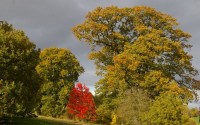Trees for the Future.
- Date
- 10 Apr 2018
- Start time
- 7:30 PM
- Venue
- Tempest Anderson Hall
- Speaker
- Dr John Grimshaw, Director: The Yorkshire Arboretum

Trees for the Future
Dr John Grimshaw, Director: The Yorkshire Arboretum*
The multifaceted benefits of trees are well-known – but they face increasing threats from disease, climate change, indifference and false economies. Advocating diversity for resilience of the future treescape, in this talk John Grimshaw, Director of the Yorkshire Arboretum, discusses the origins of our trees and the wide range of potential species for future planting.
With only about thirty species of native tree in Britain, planters have always turned to exotics from around the world to beautify our landscape or be used for timber production. Over 3000 different tree species are now cultivated here, a richness to celebrate and enjoy while assessing which may flourish – or fail – in years to come.
*The Yorkshire Arboretum is a glorious, 120 acre garden of trees in a stunning landscape of parkland, lakes and ponds in the historic setting of the Castle Howard estate near York. New trees are planted each year, and the grounds enhanced by wildflower meadows and large numbers of spring and early summer-flowering bulbs.
Member’s report
Native British trees are under enormous threat, particularly from climate change but also from disease and pests. Many of the latter are of recent import as a result of the vast increase in trade, whether in plants or in other imports brought in on infected wooden pallets.
Plants and trees have been imported since the Middle Ages, and especially since the 17th century. Many of these non-native British trees are also under threat. However, there is a huge range of new species which offer a possible solution to native losses. Hardier trees from all over the world, even from the tropics, may have to occupy empty woodland spaces and commercial forests decimated by disease. Growing and planting from seed is less environmentally risky than from imported trees.
Trees are important – for economic, environmental, and even mental health reasons. The variety of trees capable of thriving in the British Isles includes avocados, acacia, cedar, sequoia, rhododendrons, a wide range of quercus (oak) and many more. But planters of trees are often risk averse and prefer small trees. Larger trees need to be planted and diversity encouraged to obviate the risk of disease, particularly in monocultural commercial plantations.
Carole Smith